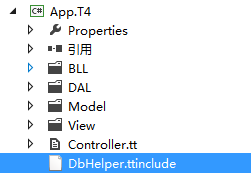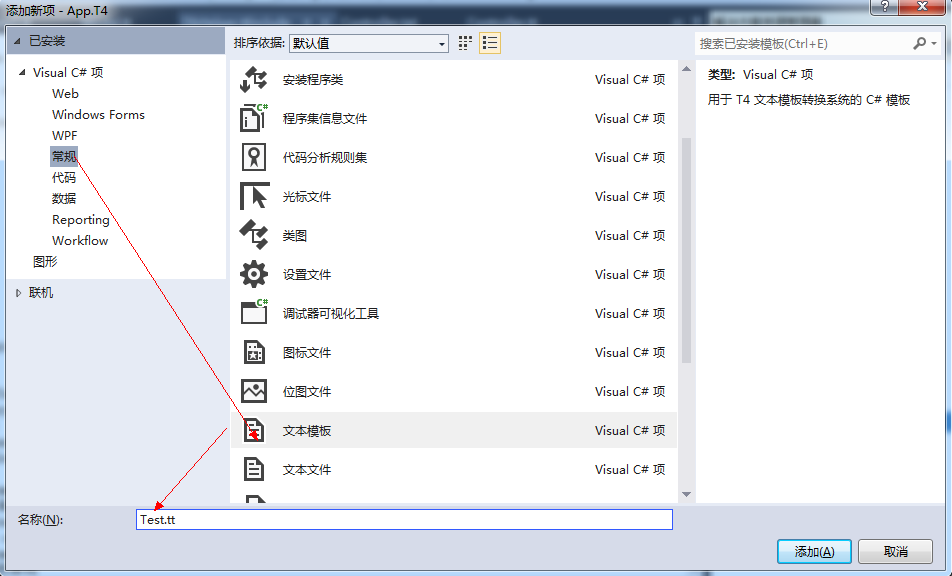原文:构建ASP.NET MVC4+EF5+EasyUI+Unity2.x注入的后台管理系统(29)-T4模版
这讲适合所有的MVC程序
很荣幸,我们的系统有了体验的地址了。演示地址
之前我们发布了一个简单的代码生成器,其原理就是读取数据库的表结构,生成文本的一个方式来生成代码!
为了替代重复的劳动,微软自己有一套T4模版,我不想把T4模版说得那么的复杂,因为这个复杂我自己也不知道。
原理跟市面的代码生成器一个道理,但是T4的扩展比代码生成器更灵活,可以更方便根据类生成代码等操作。
T4代码模式是没有颜色高亮了,但是我们的VS支持插件 T4 Editor
下载安装之后就可以跟我们写C#一样有智能高亮和提示了。
新建一个项目,专门用于T4的存放。

首先我们要让T4连接我们的数据库
新建一个DbHelper.ttinclude模版包含文件


<#+
public class DbHelper
{
#region GetDbTables
public static List<DbTable> GetDbTables(string connectionString, string database, string tables = null)
{
if (!string.IsNullOrEmpty(tables))
{
tables = string.Format(" and obj.name in ('{0}')", tables.Replace(",", "','"));
}
#region SQL
string sql = string.Format(@"SELECT
obj.name tablename,
schem.name schemname,
idx.rows,
CAST
(
CASE
WHEN (SELECT COUNT(1) FROM sys.indexes WHERE object_id= obj.OBJECT_ID AND is_primary_key=1) >=1 THEN 1
ELSE 0
END
AS BIT) HasPrimaryKey
from {0}.sys.objects obj
inner join {0}.dbo.sysindexes idx on obj.object_id=idx.id and idx.indid<=1
INNER JOIN {0}.sys.schemas schem ON obj.schema_id=schem.schema_id
where type='U' {1}
order by obj.name", database, tables);
#endregion
DataTable dt = GetDataTable(connectionString, sql);
return dt.Rows.Cast<DataRow>().Select(row => new DbTable
{
TableName = row.Field<string>("tablename"),
SchemaName = row.Field<string>("schemname"),
Rows = row.Field<int>("rows"),
HasPrimaryKey = row.Field<bool>("HasPrimaryKey")
}).ToList();
}
#endregion
#region GetDbColumns
public static List<DbColumn> GetDbColumns(string connectionString, string database, string tableName, string schema = "dbo")
{
#region SQL
string sql = string.Format(@"
WITH indexCTE AS
(
SELECT
ic.column_id,
ic.index_column_id,
ic.object_id
FROM {0}.sys.indexes idx
INNER JOIN {0}.sys.index_columns ic ON idx.index_id = ic.index_id AND idx.object_id = ic.object_id
WHERE idx.object_id =OBJECT_ID(@tableName) AND idx.is_primary_key=1
)
select
colm.column_id ColumnID,
CAST(CASE WHEN indexCTE.column_id IS NULL THEN 0 ELSE 1 END AS BIT) IsPrimaryKey,
colm.name ColumnName,
systype.name ColumnType,
colm.is_identity IsIdentity,
colm.is_nullable IsNullable,
cast(colm.max_length as int) ByteLength,
(
case
when systype.name='nvarchar' and colm.max_length>0 then colm.max_length/2
when systype.name='nchar' and colm.max_length>0 then colm.max_length/2
when systype.name='ntext' and colm.max_length>0 then colm.max_length/2
else colm.max_length
end
) CharLength,
cast(colm.precision as int) Precision,
cast(colm.scale as int) Scale,
prop.value Remark
from {0}.sys.columns colm
inner join {0}.sys.types systype on colm.system_type_id=systype.system_type_id and colm.user_type_id=systype.user_type_id
left join {0}.sys.extended_properties prop on colm.object_id=prop.major_id and colm.column_id=prop.minor_id
LEFT JOIN indexCTE ON colm.column_id=indexCTE.column_id AND colm.object_id=indexCTE.object_id
where colm.object_id=OBJECT_ID(@tableName)
order by colm.column_id", database);
#endregion
SqlParameter param = new SqlParameter("@tableName", SqlDbType.NVarChar, 100) { Value = string.Format("{0}.{1}.{2}", database, schema, tableName) };
DataTable dt = GetDataTable(connectionString, sql, param);
return dt.Rows.Cast<DataRow>().Select(row => new DbColumn()
{
ColumnID = row.Field<int>("ColumnID"),
IsPrimaryKey = row.Field<bool>("IsPrimaryKey"),
ColumnName = row.Field<string>("ColumnName"),
ColumnType = row.Field<string>("ColumnType"),
IsIdentity = row.Field<bool>("IsIdentity"),
IsNullable = row.Field<bool>("IsNullable"),
ByteLength = row.Field<int>("ByteLength"),
CharLength = row.Field<int>("CharLength"),
Scale = row.Field<int>("Scale"),
Remark = row["Remark"].ToString()
}).ToList();
}
#endregion
#region GetDataTable
public static DataTable GetDataTable(string connectionString, string commandText, params SqlParameter[] parms)
{
using (SqlConnection connection = new SqlConnection(connectionString))
{
SqlCommand command = connection.CreateCommand();
command.CommandText = commandText;
command.Parameters.AddRange(parms);
SqlDataAdapter adapter = new SqlDataAdapter(command);
DataTable dt = new DataTable();
adapter.Fill(dt);
return dt;
}
}
#endregion
}
#region DbTable
/// <summary>
/// 表结构
/// </summary>
public sealed class DbTable
{
/// <summary>
/// 表名称
/// </summary>
public string TableName { get; set; }
/// <summary>
/// 表的架构
/// </summary>
public string SchemaName { get; set; }
/// <summary>
/// 表的记录数
/// </summary>
public int Rows { get; set; }
/// <summary>
/// 是否含有主键
/// </summary>
public bool HasPrimaryKey { get; set; }
}
#endregion
#region DbColumn
/// <summary>
/// 表字段结构
/// </summary>
public sealed class DbColumn
{
/// <summary>
/// 字段ID
/// </summary>
public int ColumnID { get; set; }
/// <summary>
/// 是否主键
/// </summary>
public bool IsPrimaryKey { get; set; }
/// <summary>
/// 字段名称
/// </summary>
public string ColumnName { get; set; }
/// <summary>
/// 字段类型
/// </summary>
public string ColumnType { get; set; }
/// <summary>
/// 数据库类型对应的C#类型
/// </summary>
public string CSharpType
{
get
{
return SqlServerDbTypeMap.MapCsharpType(ColumnType);
}
}
/// <summary>
///
/// </summary>
public Type CommonType
{
get
{
return SqlServerDbTypeMap.MapCommonType(ColumnType);
}
}
/// <summary>
/// 字节长度
/// </summary>
public int ByteLength { get; set; }
/// <summary>
/// 字符长度
/// </summary>
public int CharLength { get; set; }
/// <summary>
/// 小数位
/// </summary>
public int Scale { get; set; }
/// <summary>
/// 是否自增列
/// </summary>
public bool IsIdentity { get; set; }
/// <summary>
/// 是否允许空
/// </summary>
public bool IsNullable { get; set; }
/// <summary>
/// 描述
/// </summary>
public string Remark { get; set; }
}
#endregion
#region SqlServerDbTypeMap
public class SqlServerDbTypeMap
{
public static string MapCsharpType(string dbtype)
{
if (string.IsNullOrEmpty(dbtype)) return dbtype;
dbtype = dbtype.ToLower();
string csharpType = "object";
switch (dbtype)
{
case "bigint": csharpType = "long"; break;
case "binary": csharpType = "byte[]"; break;
case "bit": csharpType = "bool"; break;
case "char": csharpType = "string"; break;
case "date": csharpType = "DateTime"; break;
case "datetime": csharpType = "DateTime"; break;
case "datetime2": csharpType = "DateTime"; break;
case "datetimeoffset": csharpType = "DateTimeOffset"; break;
case "decimal": csharpType = "decimal"; break;
case "float": csharpType = "double"; break;
case "image": csharpType = "byte[]"; break;
case "int": csharpType = "int"; break;
case "money": csharpType = "decimal"; break;
case "nchar": csharpType = "string"; break;
case "ntext": csharpType = "string"; break;
case "numeric": csharpType = "decimal"; break;
case "nvarchar": csharpType = "string"; break;
case "real": csharpType = "Single"; break;
case "smalldatetime": csharpType = "DateTime"; break;
case "smallint": csharpType = "short"; break;
case "smallmoney": csharpType = "decimal"; break;
case "sql_variant": csharpType = "object"; break;
case "sysname": csharpType = "object"; break;
case "text": csharpType = "string"; break;
case "time": csharpType = "TimeSpan"; break;
case "timestamp": csharpType = "byte[]"; break;
case "tinyint": csharpType = "byte"; break;
case "uniqueidentifier": csharpType = "Guid"; break;
case "varbinary": csharpType = "byte[]"; break;
case "varchar": csharpType = "string"; break;
case "xml": csharpType = "string"; break;
default: csharpType = "object"; break;
}
return csharpType;
}
public static Type MapCommonType(string dbtype)
{
if (string.IsNullOrEmpty(dbtype)) return Type.Missing.GetType();
dbtype = dbtype.ToLower();
Type commonType = typeof(object);
switch (dbtype)
{
case "bigint": commonType = typeof(long); break;
case "binary": commonType = typeof(byte[]); break;
case "bit": commonType = typeof(bool); break;
case "char": commonType = typeof(string); break;
case "date": commonType = typeof(DateTime); break;
case "datetime": commonType = typeof(DateTime); break;
case "datetime2": commonType = typeof(DateTime); break;
case "datetimeoffset": commonType = typeof(DateTimeOffset); break;
case "decimal": commonType = typeof(decimal); break;
case "float": commonType = typeof(double); break;
case "image": commonType = typeof(byte[]); break;
case "int": commonType = typeof(int); break;
case "money": commonType = typeof(decimal); break;
case "nchar": commonType = typeof(string); break;
case "ntext": commonType = typeof(string); break;
case "numeric": commonType = typeof(decimal); break;
case "nvarchar": commonType = typeof(string); break;
case "real": commonType = typeof(Single); break;
case "smalldatetime": commonType = typeof(DateTime); break;
case "smallint": commonType = typeof(short); break;
case "smallmoney": commonType = typeof(decimal); break;
case "sql_variant": commonType = typeof(object); break;
case "sysname": commonType = typeof(object); break;
case "text": commonType = typeof(string); break;
case "time": commonType = typeof(TimeSpan); break;
case "timestamp": commonType = typeof(byte[]); break;
case "tinyint": commonType = typeof(byte); break;
case "uniqueidentifier": commonType = typeof(Guid); break;
case "varbinary": commonType = typeof(byte[]); break;
case "varchar": commonType = typeof(string); break;
case "xml": commonType = typeof(string); break;
default: commonType = typeof(object); break;
}
return commonType;
}
}
#endregion
#>
这里面包含了一些转换的方法和访问数据库的SQL语句
其中GetDbTables方法就是根据数据库的链接,表名来读取字段数据
怎么用呢?就是让模版包含这个文件,就可以访问方法了
举一个Model为例吧,新建Model文件夹。并新建文件,模版文件为tt结尾的扩展

我们新建Test.tt之后
<#@ template debug="false" hostspecific="false" language="C#" #> <#@ assembly name="System.Core" #> <#@ import namespace="System.Linq" #> <#@ import namespace="System.Text" #> <#@ import namespace="System.Collections.Generic" #> <#@ output extension=".txt" #>
最后一行<#@ output extension=".txt" #>
为模版生成的文件,可以是.cs可以是其他。我们就不改了,就是txt
如果是cs类,生成会编译,如果代码是对的,但是系统不知道是对的,会编译出错,虽然这不影响结果,但是不爽
我们为Test.tt添加如下代码
<#@ template debug="false" hostspecific="false" language="C#" #> <#@ output extension=".txt" #> <#@ assembly name="System.Core.dll" #> <#@ assembly name="System.Data.dll" #> <#@ assembly name="System.Data.DataSetExtensions.dll" #> <#@ assembly name="System.Xml.dll" #> <#@ import namespace="System" #> <#@ import namespace="System.Xml" #> <#@ import namespace="System.Linq" #> <#@ import namespace="System.Data" #> <#@ import namespace="System.Data.SqlClient" #> <#@ import namespace="System.Collections.Generic" #> <#@ import namespace="System.IO" #> <#@ include file="$(ProjectDir)DbHelper.ttinclude" #> //------------------------------------------------------------------------------ // <auto-generated> // 此代码由T4模板自动生成 // 生成时间 <#=DateTime.Now.ToString("yyyy-MM-dd HH:mm:ss")#> by YmNets // 对此文件的更改可能会导致不正确的行为,并且如果 // 重新生成代码,这些更改将会丢失。 // </auto-generated> //------------------------------------------------------------------------------
我们引入了一些命名空间,因为我们要将读到的表结构进行一系列的处理,比如for循环等操作
其中<#@ include file="$(ProjectDir)DbHelper.ttinclude" #>就是包含了刚刚简历的访问数据库文件
T4模版的语法通过上面我们可以看出是<#@#>,<#=#>,<##>,<#+#>结构跟原生的asp.net一个鸟样,不是Razor语法,这里要注意
我们添加一些代码
<#@ template debug="false" hostspecific="false" language="C#" #> <#@ output extension=".txt" #> <#@ assembly name="System.Core.dll" #> <#@ assembly name="System.Data.dll" #> <#@ assembly name="System.Data.DataSetExtensions.dll" #> <#@ assembly name="System.Xml.dll" #> <#@ import namespace="System" #> <#@ import namespace="System.Xml" #> <#@ import namespace="System.Linq" #> <#@ import namespace="System.Data" #> <#@ import namespace="System.Data.SqlClient" #> <#@ import namespace="System.Collections.Generic" #> <#@ import namespace="System.IO" #> <#@ include file="$(ProjectDir)DbHelper.ttinclude" #> //------------------------------------------------------------------------------ // <auto-generated> // 此代码由T4模板自动生成 // 生成时间 <#=DateTime.Now.ToString("yyyy-MM-dd HH:mm:ss")#> by YmNets // 对此文件的更改可能会导致不正确的行为,并且如果 // 重新生成代码,这些更改将会丢失。 // </auto-generated> //------------------------------------------------------------------------------ using System; using System.ComponentModel.DataAnnotations; namespace <#=config.nameSpace#> { public class <#=config.TableName#>Model { <# foreach(DbColumn column in DbHelper.GetDbColumns(config.ConnectionString, config.DbDatabase, config.TableName)){#> public <#= column.CSharpType#><# if(column.CommonType.IsValueType && column.IsNullable){#>?<#}#> <#=column.ColumnName#> { get; set; } <#}#> } } <#+ public class config { public static readonly string ConnectionString="Data Source=(local);Initial Catalog=AppDB;User ID=sa;Password=zhaoyun123!@#;"; public static readonly string DbDatabase="AppDB"; public static readonly string TableName="SysSample"; public static readonly string nameSpace="App.Sys"; } #>
有一些通用的我建了一个类config,访问config只需要config.TableName即可
访问DbHelper.ttinclude,值需要DbHelper.***即可
所以同道理,通用的类我们可以建造 Common.ttinclude来完善模版生成库
OK。配置好之后,值需要展开Test.tt就可以看到Test.txt文件,文件生成情况如下
//------------------------------------------------------------------------------ // <auto-generated> // 此代码由T4模板自动生成 // 生成时间 2014-03-03 17:34:45 by YmNets // 对此文件的更改可能会导致不正确的行为,并且如果 // 重新生成代码,这些更改将会丢失。 // </auto-generated> //------------------------------------------------------------------------------ using System; using System.ComponentModel.DataAnnotations; namespace App.Sys { public class SysSampleModel { public string Id { get; set; } public string Name { get; set; } public int? Age { get; set; } public DateTime? Bir { get; set; } public string Photo { get; set; } public string Note { get; set; } public DateTime? CreateTime { get; set; } } }
非常快速,所以,你可以很快建立自己项目的模版文件了。
以上只是基础,我们更加关心的是更多的扩展,比如判断数据库类型啊等等,做逻辑处理,获取字段的长度做处理啊。
所以我给大家提供一个备注:下面这条语句可以得到表的结构
<# foreach(DbColumn column in DbHelper.GetDbColumns(config.ConnectionString, config.DbDatabase, config.TableName)){#> <#}#>
其中:
column.CSharpType 字段的类型
column.IsNullable 是否为空
column.IsPrimaryKey 是否是主键
column.CharLength 字段的长度,如varchar(50)那么column.CharLength=50
column.ColumnName 字段的名称
样例:判断是否DataTime类型
<#if(column.CSharpType=="DateTime"){#>
<# } #>
一个小小的例子,我们就能看懂MVC的T4模版,并能熟练运用它

![EasyUI+JavaWeb奖助学金管理系统[20]-项目总结与展望](https://ucc.alicdn.com/pic/developer-ecology/330d6712fdf74f1f96f2bbaa9de55eb4.png?x-oss-process=image/resize,h_160,m_lfit)
![EasyUI+JavaWeb奖助学金管理系统[16]-权限管理功能的开发](https://ucc.alicdn.com/pic/developer-ecology/936b2dd43aa24f1486a170a544b8618b.png?x-oss-process=image/resize,h_160,m_lfit)
![EasyUI+JavaWeb奖助学金管理系统[14]-机构新增、编辑、删除的实现](https://ucc.alicdn.com/pic/developer-ecology/380bc346bbfa4ebd8824bc04be0ee216.png?x-oss-process=image/resize,h_160,m_lfit)



